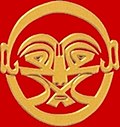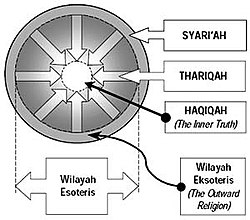Alevism
Alevism or Anatolian Alevism (Kurdish: [Rêya Heqî] Error: {{Lang}}: text has italic markup (help);[1] Persian: علویان; Turkish: [Alevilik] Error: {{Lang}}: text has italic markup (help); Azerbaijani: [Ələvilik] Error: {{Lang}}: text has italic markup (help)) is a local syncretic Anatolian tradition,[2] whose adherents follow the mystical (bāṭenī)[3] teachings of Persian[4][5][6][7][8][9] mystic Haji Bektash Veli, who is supposed to have taught the teachings of Ali and the Twelve Imams. Differing from both the mainstream Sunni and Shia, Alevis have no binding religious dogmas, and teachings are passed on by a spiritual leader. They generally acknowledge the six articles of faith of Islam, but may differ regarding their interpretation. The tradition is mainly followed by ethnic Kurds, Zazas and Turks. You must be born to an Alevi mother or father to be considered a Alevi.[10]
Alevism Media
Tomb of Ahi Evren; founder and leader of the Ahi Brotherhood, which evolved into a Beylik later on
10th of Muharram – Ashura: Husayn was martyred at Karbala. The Mourning of Muharram and the remembrance of this event by Ja'faris, Alevis, and Bektashis together in Ottoman Empire. Painted by Fausto Zonaro.
A Persian miniature depicting Elijah and al-Khiḍr (A miniature version of Stories of the Prophets)
Ottoman miniature of the founder of the Bektashiyya Sufi order Hacı Bektaş-ı Veli (Ḥājjī Baktāsh Walī)
Alevis in a demonstration in Hamburg
Calligraphic hat in Alevi-Bektashism
Four Spiritual Stations in Bektashiyyah: Sharia, tariqa, haqiqa, and the fourth station, marifa, which is considered "unseen", is actually the center of the haqiqa region. Marifa is the essence of all four stations.
Sources
- Bashir, Shahzad (2008). Olson, Carl (ed.). Celibacy and Religious Traditions. Oxford University Press. ISBN 978-0-19-530632-3.
References
- ↑ Gültekin, Ahmet Kerim (2019), Kurdish Alevism: Creating New Ways of Practicing the Religion (PDF), University of Leipzig, p. 10.
- ↑ "Alevism". Religion and Public Life. Harvard Divinity School, "Alevism is a branch of Shia Islam mixed with Tengrism and Zoroastrianism that is practiced in Turkey among ethnic Anatolian Turks and Kurds (...)"
- ↑ Radtke, B. (1988). "Bāṭen". Encyclopædia Iranica. Vol. III, Fasc. 8, pp. 859-861.
- ↑ M. Kia (2011). Daily Life in the Ottoman Empire. Greenwood Pub Group Inc. p. 169, "The Bektashis traced the origins of their order to the Persian Sufi master Hadji Baktāsh Wālī [...]"
- ↑ Algar, Hamid. (2011) "BEKTĀŠ, ḤĀJĪ". Encyclopædia Iranica. Vol. IV, Fasc. 2, pp. 116–118, "It is nonetheless highly probable that Ḥājī Bektāš did indeed form part of the westward migration that was occasioned by the Mongol invasion of Khorasan and that his origins were therefore Iranian."
- ↑ R. Khanam (2005). Encyclopaedic ethnography of Middle-East and Central Asia. Global Vision Publishing Ho. p. 142.
- ↑ The Harvard Theological Review (1909). Cambridge University Press. Vol. 2, No. 3. p. 343.
- ↑ Sayyed Hossein Nasr (1972). Sufi Essays. SUNY Press. p. 117.
- ↑ J. Birge (1937). The Bektashi Order of Dervishes. London. chapter VI. p. 22.
- ↑ "Calışma Programı". AABF Geistlichenrat (in Deutsch). Retrieved 2025-07-15.










